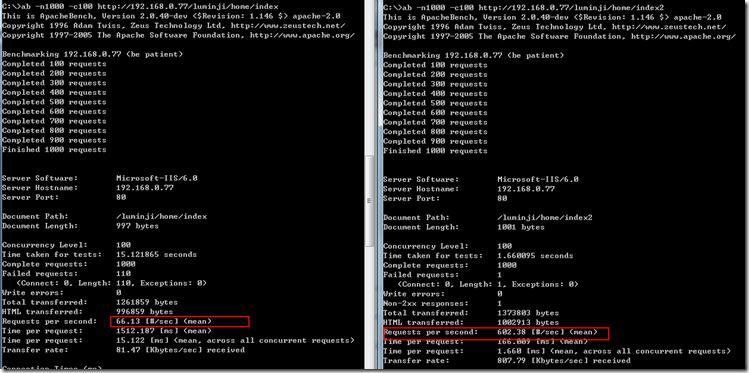ASP.NET性能优化之构建自定义文件缓存
来源:互联网 发布:捷通人才系统源码 编辑:程序博客网 时间:2024/04/30 12:25
ASP.NET性能优化之构建自定义文件缓存
ASP.NET的输出缓存(即静态HTML)在.NET4.0前一直是基于内存的。这意味着如果我们的站点含有大量的缓存,则很容易消耗掉本机内存。现在,借助于.NET4.0中的OutputCacheProvider,我们可以有多种选择创建自己的缓存。如,我们可以把HTML输出缓存存储到memcached分布式集群服务器,或者MongoDB中(一种常用的面向文档数据库,不妨阅读本篇http://msdn.microsoft.com/zh-cn/magazine/gg650661.aspx)。当然,我们也可以把缓存作为文件存储到硬盘上,考虑到可扩展性,这是一种最廉价的做法,本文就是介绍如果构建自定义文件缓存。
1:OutputCacheProvider
OutputCacheProvider是一个抽象基类,我们需要override其中的四个方法,它们分别是:
Add 方法,将指定项插入输出缓存中。
Get 方法,返回对输出缓存中指定项的引用。
Remove 方法,从输出缓存中移除指定项。
Set 方法,将指定项插入输出缓存中,如果该项已缓存,则覆盖该项。
2:创建自己的文件缓存处理类
该类型为FileCacheProvider,代码如下:
public class FileCacheProvider : OutputCacheProvider{privatestatic readonlyILog log = LogManager.GetLogger(System.Reflection.MethodBase.GetCurrentMethod().DeclaringType);publicoverride voidInitialize(stringname, NameValueCollection attributes){base.Initialize(name, attributes);CachePath = HttpContext.Current.Server.MapPath(attributes["cachePath"]);}publicoverride objectAdd(string key, object entry, DateTime utcExpiry){Object obj = Get(key);if(obj != null)//这一步很重要{returnobj;}Set(key,entry,utcExpiry);returnentry;}publicoverride objectGet(string key){stringpath = ConvertKeyToPath(key);if(!File.Exists(path)){returnnull;}CacheItem item =null;using(FileStream file = File.OpenRead(path)){var formatter =new BinaryFormatter();item = (CacheItem)formatter.Deserialize(file);}if(item.ExpiryDate <= DateTime.Now.ToUniversalTime()){log.Info(item.ExpiryDate +"*" + key);Remove(key);returnnull;}returnitem.Item;}publicoverride voidSet(string key, object entry, DateTime utcExpiry){CacheItem item =new CacheItem(entry, utcExpiry);stringpath = ConvertKeyToPath(key);using(FileStream file = File.OpenWrite(path)){BinaryFormatter formatter =new BinaryFormatter();formatter.Serialize(file, item);}}publicoverride voidRemove(stringkey){stringpath = ConvertKeyToPath(key);if(File.Exists(path))File.Delete(path);}publicstring CachePath{get;set;}privatestring ConvertKeyToPath(stringkey){stringfile = key.Replace('/','-');file +=".txt";returnPath.Combine(CachePath, file);}}[Serializable]public class CacheItem{publicDateTime ExpiryDate;publicobject Item;publicCacheItem(objectentry, DateTime utcExpiry){Item = entry;ExpiryDate = utcExpiry;}}有两个地方需要特别说明:
在Add方法中,有一个条件判断,必须做出这样的处理,否则缓存机制将会缓存第一次的结果,过了有效期后缓存讲失效并不再重建;
在示例程序中,我们简单的将缓存放到了Cache目录下,在实际的项目实践中,考虑到缓存的页面将是成千上万的,所以我们必须要做目录分级,否则寻找并读取缓存文件将会成为效率瓶颈,这会耗尽CPU。
3:配置文件
我们需要在Web.config中配置缓存处理程序是自定义的FileCacheProvider,即在 <system.web>下添加节点:
<caching><outputCachedefaultProvider="FileCache"><providers><addname="FileCache"type="MvcApplication2.Common.FileCacheProvider"cachePath="~/Cache"/></providers></outputCache></caching>4:缓存的使用
我们假设在MVC的控制中使用(如果要在ASP.NET页面中使用,则在页面中包含<%@OutputCache VaryByParam="none" Duration="10" %>),可以看到,Index是未进行输出缓存的,而Index2进行了输出缓存,缓存时间为10秒。
public class HomeController : Controller{privatestatic readonlyILog log = LogManager.GetLogger(System.Reflection.MethodBase.GetCurrentMethod().DeclaringType);staticstring s_conn = "Data Source=192.168.0.77;Initial Catalog=luminjidb;User Id=sa;Password=sa;";publicActionResult Index(){using(DataSet ds = Common.SqlHelper.ExecuteDataset(s_conn, CommandType.Text,"select top 1* from NameTb a, DepTb b where a.DepID = b.ID ORDER BY NEWID()")){ViewBag.Message = ds.Tables[0].Rows[0]["name"].ToString();}returnView();}[OutputCache(Duration = 10, VaryByParam ="none")]publicActionResult Index2(){using(DataSet ds = Common.SqlHelper.ExecuteDataset(s_conn, CommandType.Text,"select top 1* from NameTb a, DepTb b where a.DepID = b.ID ORDER BY NEWID()")){ViewBag.Message = ds.Tables[0].Rows[0]["name"].ToString();}returnView();}}5:查看下效果
上面的代码,在访问了Index2后,将会在Cache文件夹下产生缓存文件,如下:

现在,我们开始评价下有输出缓存和无输出缓存的性能对比,模拟100个用户并发1000次请求如下:

可以看到,有输出缓存后,吞吐率明显提高了10倍。
6:代码下载
FileCacheProvider的原始代码来自于网络,我修改了其中的BUG,全部代码下载如下:MvcApplication20110907.rar
- ASP.NET性能优化之构建自定义文件缓存
- ASP.NET性能优化之构建自定义文件缓存
- ASP.NET性能优化之构建自定义文件缓存
- ASP.NET性能优化之构建自定义文件缓存
- ASP.NET性能优化之构建自定义文件缓存
- ASP.NET性能优化之构建自定义文件缓存
- Asp.net 性能优化之缓存应用
- ASP.NET性能优化之局部缓存
- ASP.NET性能优化之局部缓存
- 高性能ASP.NET站点构建之托管资源优化
- ASP.NET性能优化之反向代理缓存
- ASP.NET性能优化之让浏览器缓存动态网页
- ASP.NET性能优化之让浏览器缓存动态网页
- ASP.NET性能优化之反向代理缓存
- ASP.NET性能优化之让浏览器缓存动态网页
- ASP.NET性能优化之让浏览器缓存动态网页
- ASP.NET性能优化之让浏览器缓存动态网页
- ASP.NET页面缓存优化性能优化
- Python 学习第一天
- Oracle的JDBC驱动的版本
- Java操作Hbase2
- 【PHP5权威指南】读书心得二——高级面向对象编程和设计模式
- hdu1828线段树+扫描线
- ASP.NET性能优化之构建自定义文件缓存
- IOS开发(91)之ZBar 条形码二维码扫描控件
- NDK Command
- Remainder Calculator-指数循环结+欧拉函数
- linux C之rename() & remove()
- Java操作Hbase3
- 数据库权限设计—学习
- linux shell中特殊字符的意义$0 $1 $$ $# $@
- struts2文件上传


